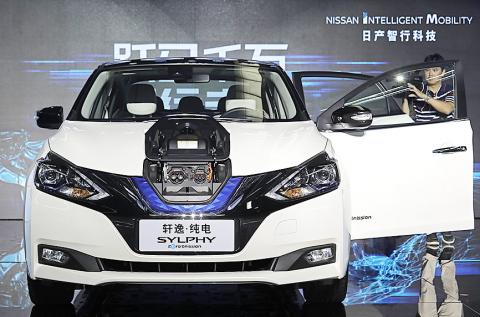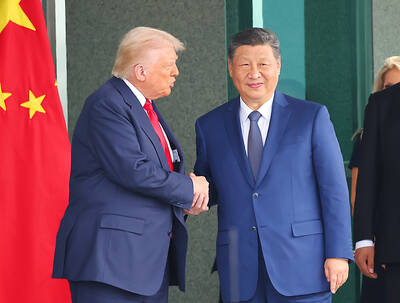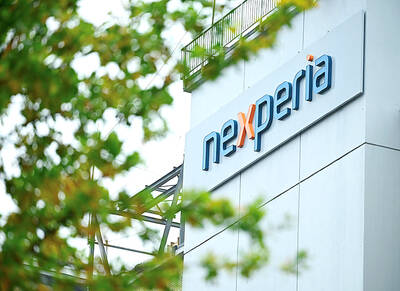Nissan Motor Co’s first electric sedan designed for China yesterday began production at the start of a wave of dozens of planned lower-cost electric vehicles (EVs) being produced by global automakers for their biggest market.
Manufacturers, including General Motors Co (GM) and Volkswagen AG, are this year to launch a flood of electric sedans, minivans and sports utility vehicles in China designed for local tastes and smaller budgets.
Nissan, Tesla Motors Inc, GM and others sell imported electric cars or electrified versions of models made by Chinese partners, but the market is dominated by low-cost local rivals including BYD Co (比亞迪).

Photo: AP
The Chinese government sees electric cars as a promising industry and a way to clean up its smog-choked cities.
It has spent heavily on subsidies to Chinese producers, and is shifting the burden to automakers with sales quotas and tougher fuel efficiency standards.
The Sylphy Zero Emission, based on Nissan’s Leaf, is being produced by Nissan and a Chinese partner, Dongfeng Group (東風集團).
The Sylphy costs 166,000 yuan (US$25,850) after government subsidies, or just more than half the sticker price of the Chinese version of the Leaf sold by Nissan and Dongfeng’s joint venture Venucia brand.
The Sylphy can go 338km on a charge, Nissan has said.
“We’re confident that the Sylphy Zero Emission rolling off the production line today will become a main player in the EV market,” Nissan chief executive officer Hiroto Saikawa said yesterday.
“We’re going to roll out a range of EVs that will appeal to customers within all market segments,” he said.
Sales quotas that are to take effect next year require every brand to sell electric vehicles or buy credits from competitors that do.
That puts pressure on automakers to design models that Chinese want and can afford.
China last year accounted for half of global electric car sales, but almost all of those came from Chinese brands including BYD Auto and BAIC Group (北汽集團).
Their prices start as low as 140,000 yuan.
“Basically, all these international giants are testing the water. They have not really launched their heavyweight models in China yet,” said industry analyst Yale Zhang (張豫) of Automotive Foresight.
“By the end of this year, things will be different,” Zhang said. “We really will see the market become more competitive and consumers will have more to choose.”
Chinese government plans call for total annual sales of 2 million electric and gasoline-electric hybrid vehicles by 2020, up from last year’s 770,000.
GM has said it will roll out 10 electric and hybrid models in China from 2016 to 2020.
By 2025, all its Buick, Cadillac and Chevrolet models in China would offer hybrid or fully electric versions, it said.
Tesla has said that China is its second-largest market.
However, a high sticker price has limited sales by other foreign brands to a few hundred vehicles.

RUN IT BACK: A succesful first project working with hyperscalers to design chips encouraged MediaTek to start a second project, aiming to hit stride in 2028 MediaTek Inc (聯發科), the world’s biggest smartphone chip supplier, yesterday said it is engaging a second hyperscaler to help design artificial intelligence (AI) accelerators used in data centers following a similar project expected to generate revenue streams soon. The first AI accelerator project is to bring in US$1 billion revenue next year and several billion US dollars more in 2027, MediaTek chief executive officer Rick Tsai (蔡力行) told a virtual investor conference yesterday. The second AI accelerator project is expected to contribute to revenue beginning in 2028, Tsai said. MediaTek yesterday raised its revenue forecast for the global AI accelerator used

TEMPORARY TRUCE: China has made concessions to ease rare earth trade controls, among others, while Washington holds fire on a 100% tariff on all Chinese goods China is effectively suspending implementation of additional export controls on rare earth metals and terminating investigations targeting US companies in the semiconductor supply chain, the White House announced. The White House on Saturday issued a fact sheet outlining some details of the trade pact agreed to earlier in the week by US President Donald Trump and Chinese President Xi Jinping (習近平) that aimed to ease tensions between the world’s two largest economies. Under the deal, China is to issue general licenses valid for exports of rare earths, gallium, germanium, antimony and graphite “for the benefit of US end users and their suppliers

Dutch chipmaker Nexperia BV’s China unit yesterday said that it had established sufficient inventories of finished goods and works-in-progress, and that its supply chain remained secure and stable after its parent halted wafer supplies. The Dutch company suspended supplies of wafers to its Chinese assembly plant a week ago, calling it “a direct consequence of the local management’s recent failure to comply with the agreed contractual payment terms,” Reuters reported on Friday last week. Its China unit called Nexperia’s suspension “unilateral” and “extremely irresponsible,” adding that the Dutch parent’s claim about contractual payment was “misleading and highly deceptive,” according to a statement

Artificial intelligence (AI) giant Nvidia Corp’s most advanced chips would be reserved for US companies and kept out of China and other countries, US President Donald Trump said. During an interview that aired on Sunday on CBS’ 60 Minutes program and in comments to reporters aboard Air Force One, Trump said only US customers should have access to the top-end Blackwell chips offered by Nvidia, the world’s most valuable company by market capitalization. “The most advanced, we will not let anybody have them other than the United States,” he told CBS, echoing remarks made earlier to reporters as he returned to Washington